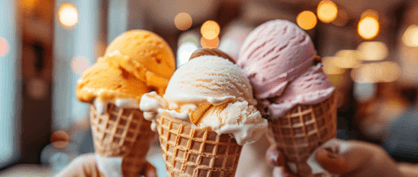Get the Scoop on the Science of Ice Cream

By Dawn Patton Mangine
Ice cream doesn’t just happen. If you put a gallon of milk or your dad’s coffee creamer in the freezer, it wouldn’t turn into ice cream. It would just freeze. In order to create this sweet, warm-weather treat, some people have made a career out of considering how ice cream is made, and more importantly, how to continually improve it.
Ice cream is chemistry; ice cream is engineering. In a word, ice cream is science. And where do we learn about science? In school.
Welcome to Ice Cream College
One of the most well-known courses on ice cream-how-to happens at The Pennsylvania State University in State College, Pennsylvania. While it’s officially named the Ice Cream Short Course, most people simply refer to it as Ice Cream College. The program, part of the Department of Food Science, is hosted at the Berkey Creamery and is for professionals and enthusiasts alike. In its 133-year history, it’s attracted participants from every state in America and from every continent except Antarctica (where, let’s face it, eating frozen treats doesn’t sound appealing).
This course is so popular, that it usually only takes days—or even hours—to reach the 120-student capacity. It’s likely that someone from your favorite ice cream brand has attended Ice Cream College. The course offers more than 20 workshops over seven days, because a lot goes into making, storing, and serving ice cream.
As wonderful as taking a course about making ice cream may sound, be advised it’s not all rainbow sprinkles. Attendees have to study, do homework, and take exams. There are sessions for students who want extra help, too. The course culminates in class rankings for the top ten students, a banquet, and the receipt of a certificate.
From Cow to Cone
Dairy-based ice cream comes from milk, and milk comes from cows. Penn State houses a herd of about 200 dairy cows to provide the dairy for their products, which include butter, cheese, milk, and their famous ice cream.
The process that turns milk into ice cream takes place at a molecular level. As Bob Roberts, PhD and head of the Department of Food Science at Penn State says: “Everything is easy when things work. When things don’t work, you need to understand the science.” For example: How do milk proteins interact with fat? What happens when you want to change an ingredient? What are ways to improve flavor?
Once the milk gets combined with cream and sugar, the base of ice cream, known as ice cream mix, is created. And that’s how ice cream production starts.
According to Ross Cohen, CEO and co-owner of Sweet Cow, a Colorado-based ice cream company, “The most important thing I learned was better understanding our ice cream mix...[and] understanding how the ingredients interact with each other.”
Once the ice cream mix is combined, it undergoes pasteurization. Flavor is added, and then the mix gets simultaneously frozen and whipped. In large factories, the mixture is pumped through a very cold tube with an internal mixing blade known as a dasher. The dasher turns to whip the cream, adding air bubbles and removing ice crystals that form on the sides of the tube. The dasher’s work is important for the texture and structure of the ice cream.
Candy, fruit, and other goodies are folded into the mixture after this step, and then the ice cream is put into containers. The containers are placed into very cold freezers for a step called hardening. The ice cream is reduced to a low temperature, below 0°F or colder. Once the ice cream is hardened, it’s ready to be shipped and sold for a sweet treat that can’t be beat.
So if you like ice cream and are interested in what happens between the cow and the grocery store freezer, Ice Cream College is the place to learn. Not only will you find out how to make ice cream, but you will learn how to make it better.
Ice Cream Fun Facts
- Eight percent of all the milk produced in the United States ends up in a frozen dairy product. Ice cream and other frozen dairy desserts usually consist of milk fat, non-fat milk solids, sugar, and air bubbles, plus emulsifiers and stabilizers (think egg whites or xanthan gum) for texture.
- According to the U.S. Department of Agriculture (USDA), to be classified as ice cream, a frozen dairy product must contain 10 percent or more milk fat and a minimum of six percent non-fat milk solids.
- A gallon of ice cream should weigh four and a half pounds.
- The range of milk fat in commercially sold ice cream is usually between 10 and 16 percent, with most premium brands containing 14 percent.
- Soft serve ice cream does not go through the hardening process that is the final step in most ice-cream making.
- The average American eats 20 pounds of ice cream a year, or approximately four gallons.
Activity
Five-Minute Ice Cream
Ingredients: Sugar; heavy cream, milk, or half-and-half; flavor additives (vanilla extract, chocolate syrup, malt powder, candy, or fruit)
Supplies: Zip-top plastic bags, one gallon-sized, one pint-sized; ice; salt (rock salt works best)
Steps:
- In the smaller zip-top bag, combine 1 tablespoon sugar; ½ cup dairy; and vanilla (or other extract) to taste. Seal the bag.
- Fill the large zip-top bag with ice and 6 tablespoons of salt.
- Bury the smaller bag in the ice and shake vigorously for five minutes.
- Once you have your frozen cream, feel free to fold in syrups, candy, or fruit.